Essay writing is easier than you think
The very first reaction I usually get when I want to practise essay writing with my students is wild panic. Everybody around me starts rolling on the floor crying and screaming. I try to calm them down, but there is no way of doing it and eventually all of them quit and tell me that they will never be able to pass the FCE exam.
Of course, this was a little bit of an exaggeration, but it is true that most students get stressed as soon as they here the word essay when, actually, there is no real reason for that. In fact, essay writing might be the easiest type of writing in Cambridge B2 First because there is a plan that you can follow every single time you sit down with pen and paper to practise as well as in the exam itself.
So, let’s look at essays, how they are organised and what exactly you have to be careful with in order to pass easily and get the high marks you deserve.
- Cambridge B2 First (FCE): How to Write an Email/Letter
- Cambridge B2 First (FCE): How to Write an Essay
- Cambridge B2 First (FCE): How to Write a Review
- Cambridge B2 First (FCE): How to Write a Report
- Cambridge B2 First (FCE): How to Write an Article
- Cambridge B2 First (FCE): How to Write an Email/Letter
- Cambridge B2 First (FCE): How to Write an Essay
What a typical essay task looks like
Looking at different essay tasks, the first thing that students often realise is that all tasks look the same. Their structure doesn’t change, which gives you the advantage of being able to plan a strategy before you even take the exam. Every time you practise is like the real exam.
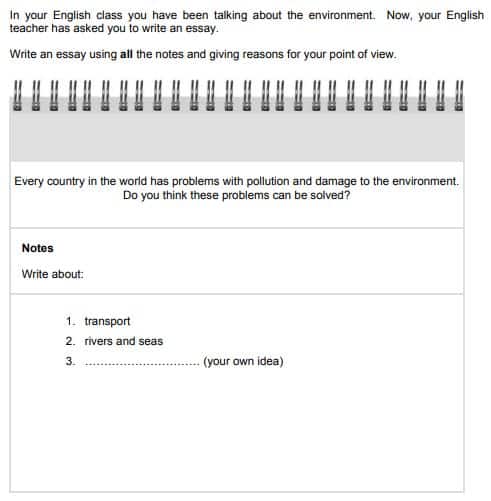
Above there is a typical essay task. As you can see there is not a lot of information, but we still have to look at it carefully and decide what we are asked to do exactly.
The first step is always to underline the key points in the task so you know what to do and what information to include in your essay.
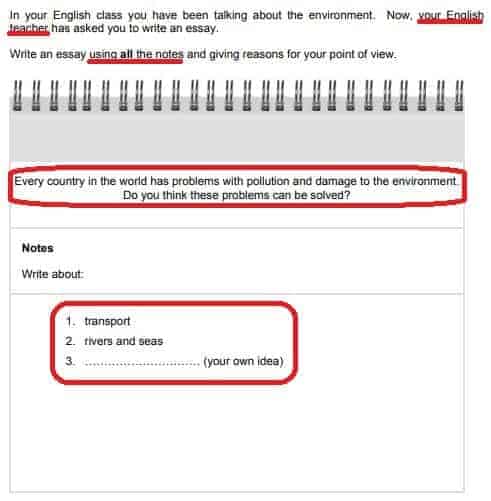
In the image above I underlined and circled the most important information for you. When you look at a writing task – and I mean every kind of writing task, not only essays – you should think about two things: what you have to include in your text and who is going to read it.
While the first point seems obvious students often forget about the second one and miss out on higher marks. In our example your English teacher is going to read the essay. What does that mean for you when you write it? Think about the style and tone of the language you are going to use. Does your English teacher expect informal language like in a text message to your best friend or should it be rather formal? I think you understand what I mean.
Choosing the correct register and tone (formal English) for your essay will earn you higher marks so don’t forget about it.
The second point we need to consider is what we have to write about. In every essay task there are a situation/topic (problems with pollution and damage to the environment), a question for you to answer (Do you think these problems can be solved?) and three topic points (transport, rivers/seas, your own idea).
You must deal with all these things if you want to pass with high marks. If something is missing you will lose marks. That includes your own idea. I see it all the time that students write about the two ideas given in the task, but they ignore the fact that they have to add a third topic on their own. Don’t make the same mistake. Always write about all three topic points.
With this flood of information the next step is to think about how we can organise our essay. Luckily, there is a plan that works and I’m going to share it with you.
The 3 main parts of an essay
Looking back at our example from before we can see that there are three topic points which we need to deal with: transport, rivers and seas as well as your own idea.

I think it is not difficult to see that we can turn these three topics into three paragraphs, one for each idea. These three paragraphs are called the body of the essay. However, an essay wouldn’t be an essay without an introduction at the beginning and a conclusion at the end. All together that’s five paragraphs and we could structure it like this:
- Introduction
- Transport
- Rivers and seas
- Your own idea
- Conclusion
With an introduction, body and conclusion every essay has three main parts. You can follow this for any essay question in the FCE exam and it works every single time.
Yeah, it sounds good to me too. 🙂
But what exactly do we have to include in these different parts? Let me give you an overview so you get a better idea.
Introduction
When I read the introduction to an essay I can often tell immediately if the essay is going to be great or if the student needs to work more on it. Think of the introduction as an appetizer before the meal begins. It gives you an idea of what to expect so you don’t want to disappoint the reader from the start.
Your introduction should always put the topic in the context of today’s world and paraphrase the question of the essay. It is also a good idea to include your opinion so the reader knows from the beginning what you think.
Let’s have a look at an example introduction for an essay about the above topic:
More and more countries and cities struggle with dirty air and water and while it is difficult to find a solution to these issues, I believe that there are ways to improve the situation and to protect the environment.
In this introduction all the key elements are covered. The topic is put in context (“More and more countries and cities struggle with…”), the question is paraphrased (“…while it is difficult to find a solution to these issues,…”) and the candidates opinion is clear (“I believe that…”).
All you need to do is to memorise this formula and use it in every essay you write. The examiner and you will be happy. 🙂
Body
The body is like the meat in a hamburger. It’s the best part and you want it to be full of flavour. For your essay it means the following:
Each paragraph of the body starts with a topic sentence which introduces the main idea of the paragraph. After that, you add reasons, examples and you can even acknowledge other points of view.
A great topic paragraph in the body doesn’t just talk about advantages and disadvantages. Think about how you can support the message in your topic sentence to convince the reader.
Here is an example for you.
Firstly, congestion on roads not only in major cities, but also in smaller towns causes a lot of pollution and noise and even though this situation seems to get worse and worse many countries are trying to encourage people to use alternatives like electric cars, which is a good first step to deal with this kind of challenge.
In this example paragraph the candidate simply followed the formula from above. The first sentences states what the problem is. After that, she acknowledges that the issue seems pretty bad, but then she explains different alternatives to cars that could improve the situation.
Also, notice the different linking expressions she uses in this paragraph (Firstly, not only…but also, and even though, which is). Examiners like a variety of linking words and phrases to connect your ideas so try to include them in your essay.
That’s really all you need to do. Repeat the same process for the other two topic points and you should be able to impress and achieve great marks.
Conclusion
Last but not least, a good essay is rounded off with a nice conclusion. Here, it is your job to tie everything together like a Christmas present. You don’t want the gift wrapping paper or the bow on the present to be ugly so make sure that you conclusion is on point.
In a good conclusion you should summarise the essay in one sentence and clearly state your opinion on the question one last time.
I told you above that the introduction is there to make a good first impression on the reader. The conclusion plays the role of giving a good last impression. You don’t want the examiner to be happy until the end and then read a conclusion that is only average. Make sure that every part is great.
To sum up, our environment needs our help and although the air we breathe as well as waterways in many parts of the world are heavily polluted I strongly believe that we can solve these issues if governments and the people work together.
The first part of this conclusion summarises the problem one last time and in the second half the candidate clearly states her opinion and that’s it. Don’t make your life harder than it already is and instead focus on the criteria that really matter.
Plan before you write
Earlier we had a look at the different paragraphs in an essay and I told you that five is a good number. A lot of students take this information and jump straight into writing as soon as they see the task.
Stop right there! When you plan to improve something around your house or in your apartment, do you just run to the store and buy five buckets of paint or do you think about the size of the room and how much paint you need, what colour you want and what kind of brushes and paint rollers you will have to get?
Treat your essay like a home improvement project and make a plan before you start writing. It only takes five minutes, but, in the end, it can save you time because once you start, you don’t have to worry about ideas any more…it’s all there in your notes.
To create a plan make a list of the five paragraphs of your essay. As we said before this could be something like this:
- Introduction
- Transport
- Rivers and seas
- Your own idea
- Conclusion
Now, all you have to do is to add a few words to each point so you won’t forget what you want to write about. I thought of a few things for our example task:
- Introduction – problems with pollution, is there a solution?
- Transport – -: CO2 emissions, noise +: electric cars
- Rivers and seas – -: sea life and plastic +: projects to clean oceans
- Animal agriculture – -: CO2 emissions, excrement +: vegan/vegetarian lifestyles, sustainable farms
- Conclusion – summary, it’s a big problem but there is hope
It took me about three minutes to write this and if I wanted to write the full essay, I would have all the ideas I need already in front of me. The next step would be to add more information to each point and voilà, the essay is done.
How your essay is marked
Marking FCE writing tasks is like a science and for a lot of students it feels as if there is this big mystery and nobody really knows how it works. Actually, there are very clear rules that the examiners have to follow and the criteria are publicly available.
While it is possible to find all the information on your own I thought it would be a good idea to put everything together in an article for you. Check out how your writing tasks are marked by clicking here.
Practice makes perfect
I hope that my article is going to help you with your essays. As you saw you can analyse and structure every task the same way. With all your new knowledge the only thing you have to do is start practising. If you put in the time and work, essay writing will become quite easy and you can focus on other areas of your English that need more improvement.
Lots of love,
Teacher Phill 🙂

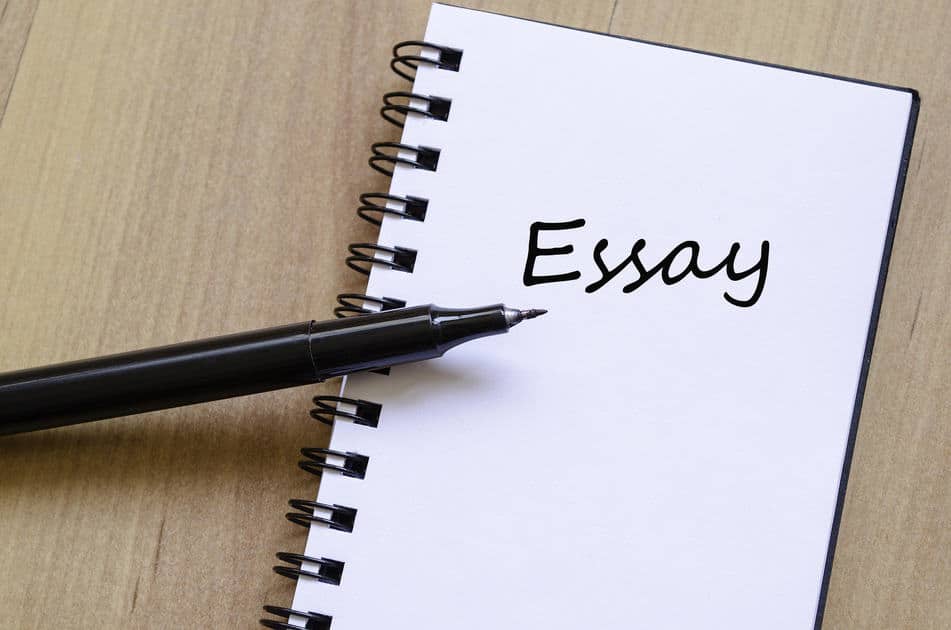
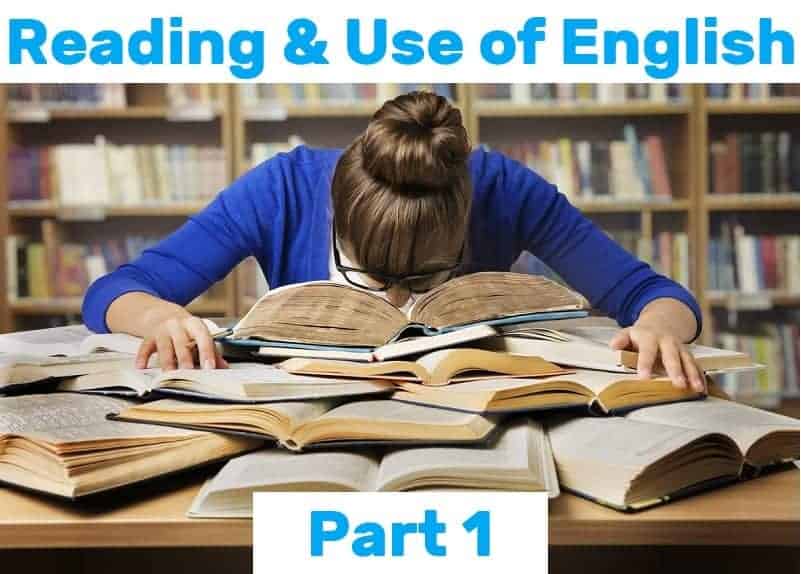
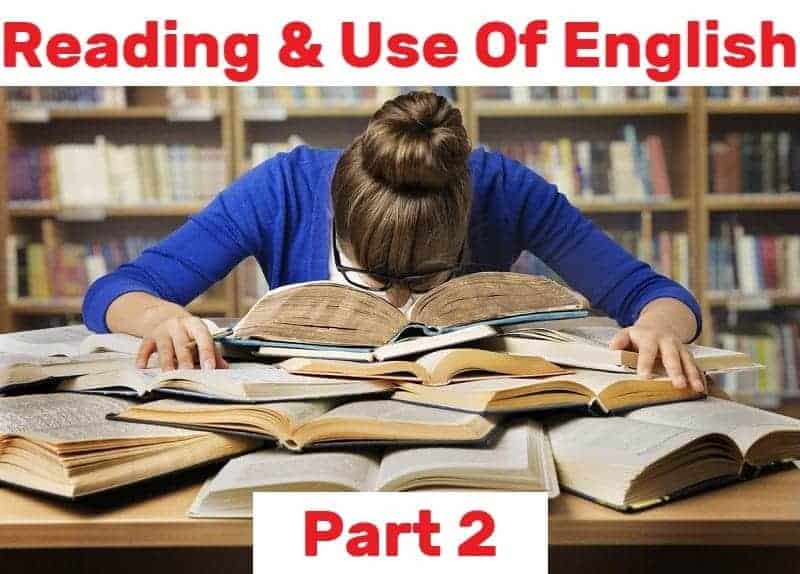

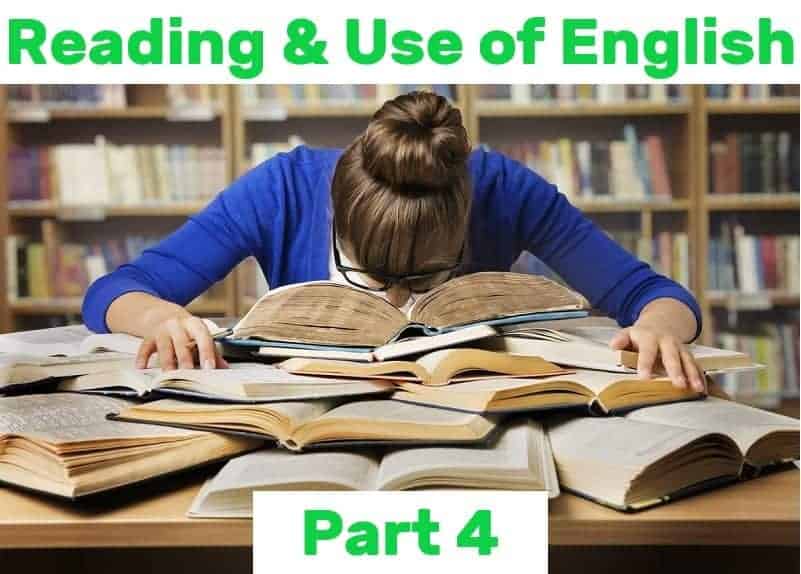







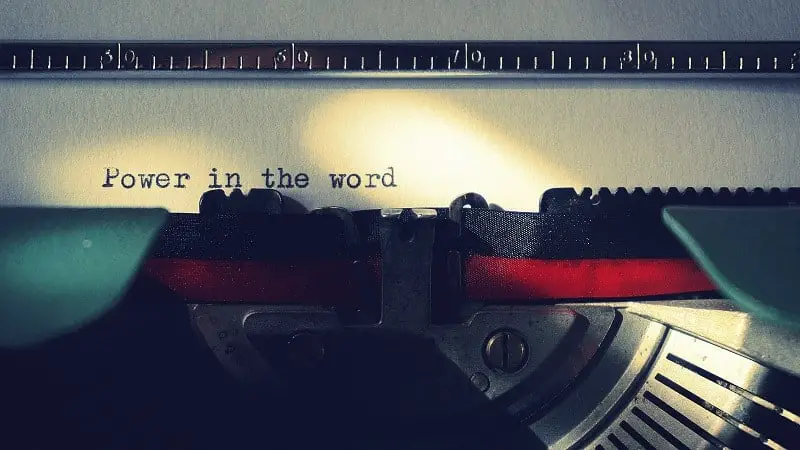

Hi, Phill!
Thanks a million for your fine tips on how to write an essay and the clear video instruction as well as brilliant associations with present giving ( like wrapping paper, a present bow and so on) while talking about a conclusion.
Hi there!
I have a question about the type of task in the essay. I know we are usually asked to write an opinion essay, but is it possible to get a task where we are asked to write a for and against essay? How can I tell these two tasks apart?
Thank you very much for you help! Your blog is really useful. 🙂
Love,
Naty
Hi Naty,
You might get a question in the essay that asks, for example, for advantages and disadvantages of a certain topic, but you always have to include three specific topic points. Because of this, you can simply choose which topic points you see as advantages and which ones as disadvantages and write three topic paragraphs. The structure stays the same, you only change the content so it fits the question.
I hope this helps. 🙂